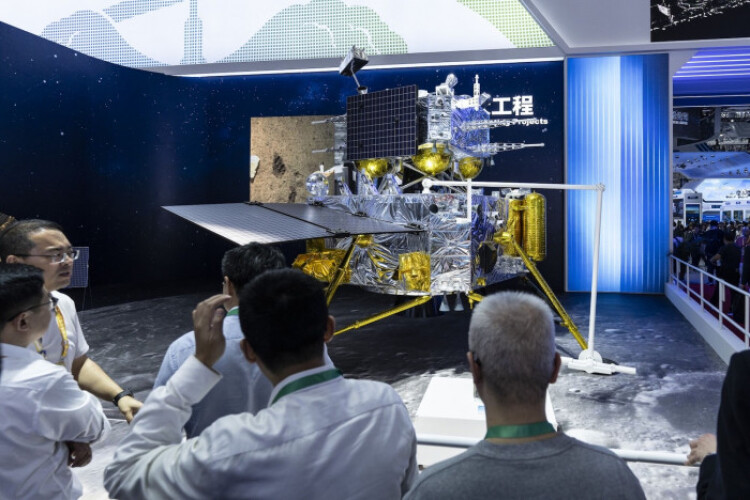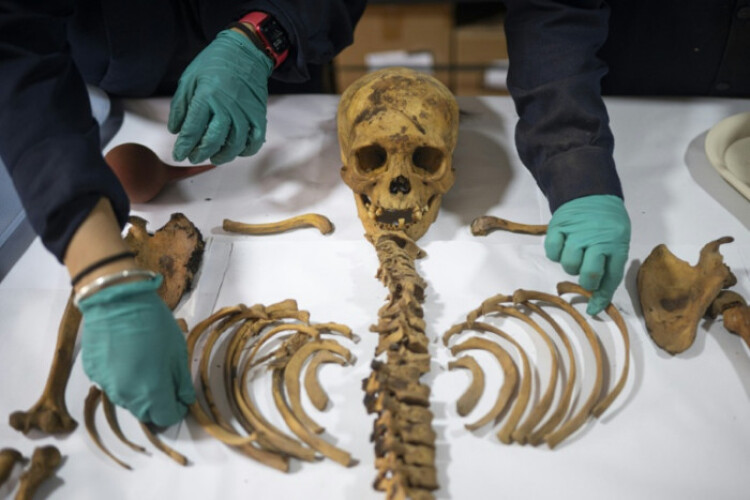
China’s Chang’e-6 robotic spacecraft in June made history by retrieving the first surface samples from the far side of the moon, which perpetually faces away from Earth. That material is now providing new insight into the moon’s geological history, including the oldest evidence to date of lunar volcanism.
Researchers said on Friday the soil brought back from the Chang’e-6 landing site contained fragments of volcanic rock — basalt — dating to 4.2 billion years ago and to 2.8 billion years ago. This points to a long period of volcanic activity — at least 1.4 billion years — on the far side during the first half of the moon’s history, when it was a more dynamic world than it is today.
The moon, like Earth, formed about 4.5 billion years ago. Volcanism on the moon, Earth and other planetary bodies involves the eruption of molten rock from the mantle — the layer just under the outer crust — onto the surface. The landing site in the South Pole-Aitken Basin, an impact crater, is an area with the thinnest crust on the moon, helpful for finding evidence of volcanism.
The Chang’e-6 probe used a scoop and drill to obtain about 1,935 grammes of soil. It then returned the material to Earth, landing in the Chinese region of Inner Mongolia.
“The Chang’e-6 samples provide a unique opportunity to study far side volcanism,” said lunar scientist Qiu-Li Li of the Chinese Academy of Sciences, who helped lead the study in the journal Nature, one of two published on Friday detailing the findings, the other in the journal Science.
The samples contained various volcanic rock fragments, and the researchers used a method called radioisotope dating to determine their age.
Lunar basalt samples previously were obtained from the moon’s near side, which perpetually faces Earth, during US Apollo, Soviet Luna and Chinese Chang’e-5 missions. These showed that volcanism on the near side had occurred as long ago as 4.0 billion years ago and continued for at least two billion years, Li said.
“The exact timing and duration of lunar volcanism is elusive and maybe varied across different regions. Some small-scale volcanism may have also occurred on the near side as late as about 120 million years ago as recorded by volcanic glass beads from Chang’e-5 samples” collected in 2020, Li said.
The new study also found that the basalt dating to 4.2 billion years ago differed in composition from the basalt dating to 2.8 billion years ago, meaning they originated from different sources of molten rock — magma — in the mantle, Li said.
The Chang’e-6 samples, Li said, also differ in composition compared with previously collected lunar samples from the near side.
There is no evidence of active volcanism on the moon, unlike other places in the solar system such as Venus and Earth.
“The cessation of volcanism on the moon is due to internal heat sources dwindling over time. Initially, the moon’s volcanic activity was driven by the decay of radioactive elements and the residual heat from its formation, which created enough internal energy to sustain mantle melting and, consequently, surface volcanic eruptions,” Li said.
“As these heat sources diminished, the moon’s mantle progressively cooled and solidified, reducing the ability of magma to reach the surface. The smaller size of the moon compared to Earth also contributed to this faster cooling rate, as smaller planetary bodies lose heat more rapidly,” Li said.
The moon’s diameter of about 3,475km is a bit more than a quarter of Earth’s diameter.
“Eventually, the temperature of the lunar interior dropped below the threshold needed to sustain volcanic activity, marking the end of significant volcanism,” Li said.
Researchers said on Friday the soil brought back from the Chang’e-6 landing site contained fragments of volcanic rock — basalt — dating to 4.2 billion years ago and to 2.8 billion years ago. This points to a long period of volcanic activity — at least 1.4 billion years — on the far side during the first half of the moon’s history, when it was a more dynamic world than it is today.
The moon, like Earth, formed about 4.5 billion years ago. Volcanism on the moon, Earth and other planetary bodies involves the eruption of molten rock from the mantle — the layer just under the outer crust — onto the surface. The landing site in the South Pole-Aitken Basin, an impact crater, is an area with the thinnest crust on the moon, helpful for finding evidence of volcanism.
The Chang’e-6 probe used a scoop and drill to obtain about 1,935 grammes of soil. It then returned the material to Earth, landing in the Chinese region of Inner Mongolia.
“The Chang’e-6 samples provide a unique opportunity to study far side volcanism,” said lunar scientist Qiu-Li Li of the Chinese Academy of Sciences, who helped lead the study in the journal Nature, one of two published on Friday detailing the findings, the other in the journal Science.
The samples contained various volcanic rock fragments, and the researchers used a method called radioisotope dating to determine their age.
Lunar basalt samples previously were obtained from the moon’s near side, which perpetually faces Earth, during US Apollo, Soviet Luna and Chinese Chang’e-5 missions. These showed that volcanism on the near side had occurred as long ago as 4.0 billion years ago and continued for at least two billion years, Li said.
“The exact timing and duration of lunar volcanism is elusive and maybe varied across different regions. Some small-scale volcanism may have also occurred on the near side as late as about 120 million years ago as recorded by volcanic glass beads from Chang’e-5 samples” collected in 2020, Li said.
The new study also found that the basalt dating to 4.2 billion years ago differed in composition from the basalt dating to 2.8 billion years ago, meaning they originated from different sources of molten rock — magma — in the mantle, Li said.
The Chang’e-6 samples, Li said, also differ in composition compared with previously collected lunar samples from the near side.
There is no evidence of active volcanism on the moon, unlike other places in the solar system such as Venus and Earth.
“The cessation of volcanism on the moon is due to internal heat sources dwindling over time. Initially, the moon’s volcanic activity was driven by the decay of radioactive elements and the residual heat from its formation, which created enough internal energy to sustain mantle melting and, consequently, surface volcanic eruptions,” Li said.
“As these heat sources diminished, the moon’s mantle progressively cooled and solidified, reducing the ability of magma to reach the surface. The smaller size of the moon compared to Earth also contributed to this faster cooling rate, as smaller planetary bodies lose heat more rapidly,” Li said.
The moon’s diameter of about 3,475km is a bit more than a quarter of Earth’s diameter.
“Eventually, the temperature of the lunar interior dropped below the threshold needed to sustain volcanic activity, marking the end of significant volcanism,” Li said.










